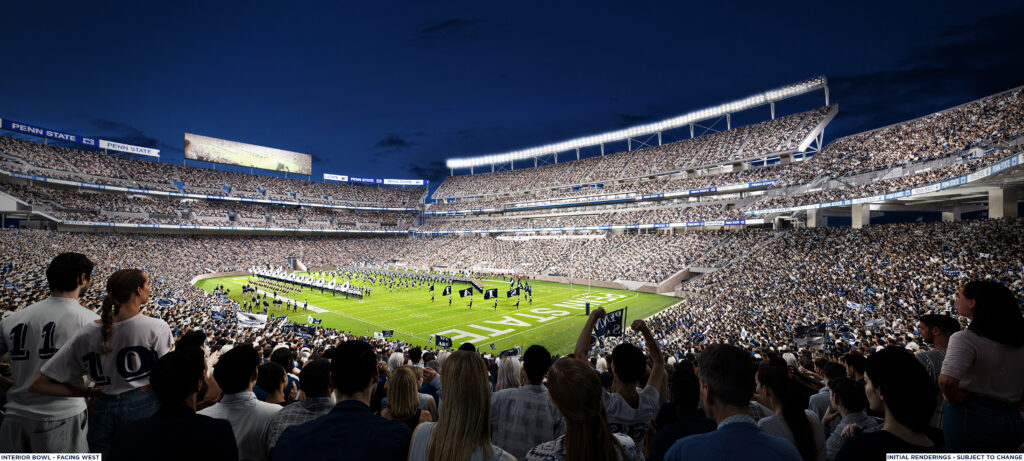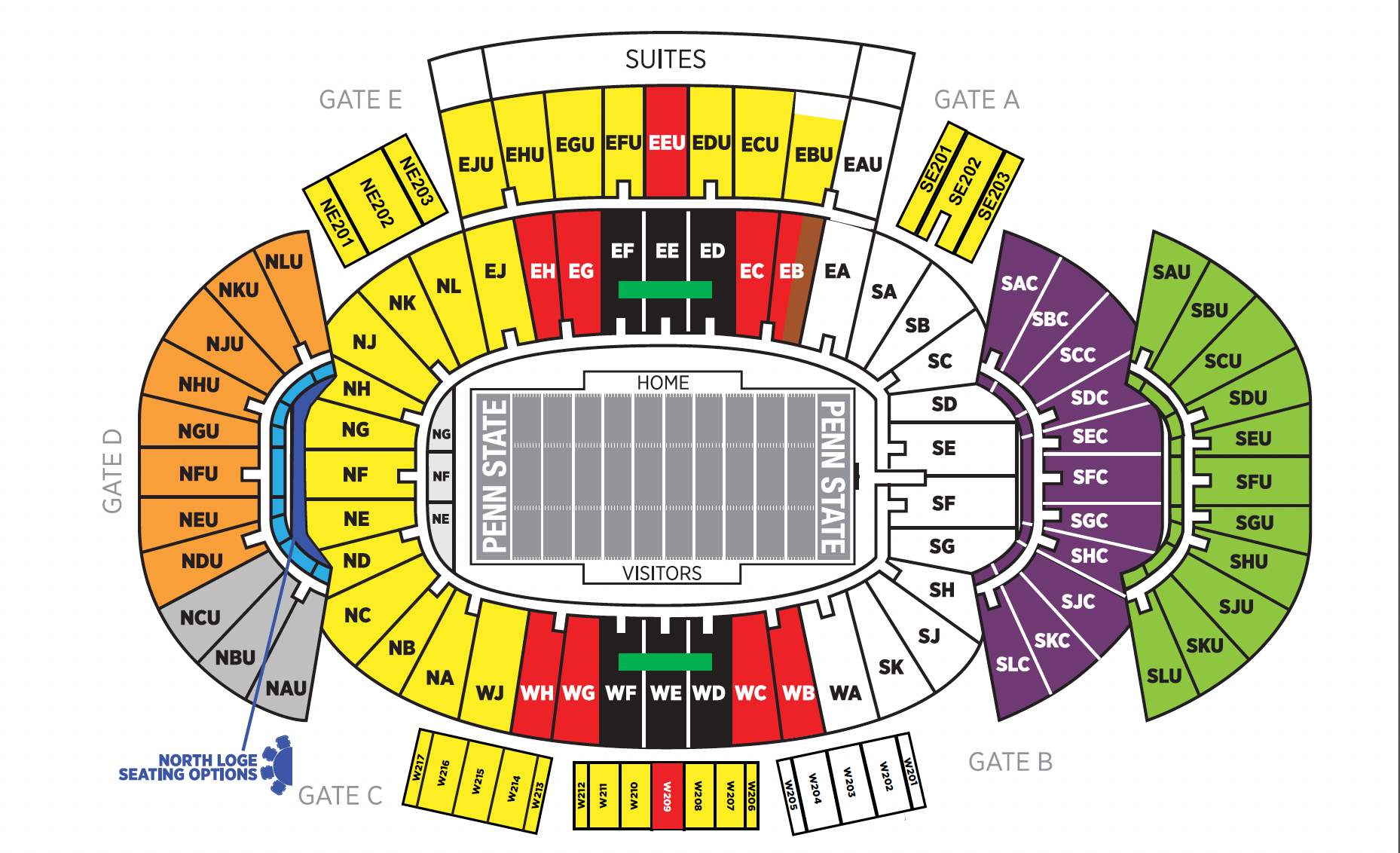
If you’re not from this part of the country or don’t pay attention to college football, I have to imagine it is a bit confusing as to why Penn State’s football team is called the “Nittany Lions” and I have to imagine it’s even more confusing that Penn State’s Nittany Lions play their football inside Beaver Stadium.
And it’s not named for an animal but rather a Civil War field commander who was wounded four times and later went on to become the governor of Pennsylvania.
But you already knew all of that.
What you’ve come here for is a search for more answers about Beaver Stadium – mainly what’s happening with the $700 million renovation that is changing the way Penn State’s football stadium will look forever.
Below are some of the questions you might have and hopefully some of the answers to those questions. Additionally, we’ll keep updating this with those questions and answers and facts and figures and other ramblings about Penn State’s football home.
What’s Happening?
In the simplest form, a renovation. In a slightly wordier form, a $700 million damn-near reconstruction of Beaver Stadium’s entire west side.
Why Is It Happening?
OK, if you read the beginning of this article, you got a little bit of a history lesson. You’re now about to get a second one. In 1960, Penn State moved Beaver Field – located in the general vicinity of the Nittany Lion Inn – to the other end of campus.
They picked the stadium up piece-by-piece and basically put it back together in the present location. Back then, Beaver Stadium didn’t have a full bowl. In fact, it looked more like a horseshoe. Eventually, they filled that in though.
A bunch of years rolled on by and then they did this thing called the “Big Lift” where they lifted the existing bowl up to make the stadium bigger. Then in the late 1980s and early 1990s, they added a north deck. Then they added the suites presently on the east side of the stadium (the side that says “The Pennsylvania State University”) and then opened up the southern deck – complete with the Mount Nittany Club in 2001.
(If you want more history of Beaver Stadium, I highly recommend “Lair Of The Lion: A History of Beaver Stadium” by Harry West and Lee Stout.)
They didn’t touch the west side of the stadium for the most part though. The press box expanded a bit – but not much. Apparently, there was rust falling in people’s food.
It was time to fix it. The giant erector set that is Beaver Stadium has sat out for nearly 65 winters with little-to-no TLC.
So in May 2024, Penn State’s Board of Trustees approved the $700 million renovation that will be a new chapter in the storied stadium.
There was some debate – and pushback from a few members of the Board of Trustees – that a smaller renovation would suffice but primarily spearheaded by athletic director Pat Kraft, the larger renovation was approved.
The goal – as the initial proposal alluded to – was to turn Beaver Stadium into a place that can be used year-round.
Additionally, Kraft has expressed interest in hosting non-football events at the stadium, one of which already happened in the form of a Luke Combs concert. Additionally, Kraft said Penn State has been passed by for events that Ohio State is hosting.
A big emphasis in the preamble to getting the renovation approved was the increase in premium seating.
How Long Is It Going To Take?
The quick answer: It’s supposed to be done by the start of the 2027 football season. So just about three years.
The longer answer: The process actually started before the 2024 football season with winterization efforts taking place to support Penn State’s potential College Football Playoff game in 2024, which ended up happening on a relatively cold day.
That’s all done and included things like the winterization and the replacement of many – but not all – ceramic troughs in men’s bathrooms around the stadium. There were also some WiFi improvements – but that fix only seemed to work in the concourse of the stadium. Plus a lot of ribbon boards. Like a ton. So many ribbon boards. All of that took $70 million of the $700 million total.
There are three phases after that. Right now, we’re seeing (you can watch them on this webcam) the first phase. After Penn State knocked down the press box with a “felling” which is a technical term I had never heard before but will never unhear now, it removed the top half of the western sideline’s stands.
There will be temporary seats added for the 2025 season (but more on that later).
And right now, that’s about all we know. Eventually, it will look like a football stadium though.
What Will It Look Like?
So yeah, what will it look like?
Well for starters, scroll up and look at the picture at the top of this page.
There are a bunch of other pictures here as well. Initially, Penn State only released the outside-of-the-stadium renderings.
Then in February, they gave us the good bits.
There are four levels with more opportunity for those premium seats Kraft was looking for. Of course, no other part of Beaver Stadium has more than two decks. Additionally, there will be lights across the entire sideline at the top deck.
The stadium will also be about 30 feet taller, according to the Centre Daily Times and will be 100 feet closer to the field. (How that will work remains to be seen but it’s in the plans.)
Some have said the look is similar to Kyle Field at Texas A&M and, honestly, yeah they could be related. In fact, they might be as Populous was the main architecture firm in College Station and is the main one in University Park. A side note that Scott Radecic – a former Penn State football player – is the founder of Populous so you’re starting to connect all of the dots now and I’m proud of you for that.
The outside looks like a football stadium. It reminds me a bit of Lambeau Field in some ways. At this point, there’s not that much interesting you can do to a massive football stadium to give it a distinct look.
How Much Will It Cost?
$700 million. I’ve said that a few times now. C’mon keep up.
OK, the better question is – where are they getting the money from?
Well, a few places. Penn State is trying to raise $130 million from donors and according to the CDT, it’s about halfway there.
The rest will come from things like “fundraising, concessions, naming opportunities, sponsorships and ticket sales.” As underlined and bolded in the initial plan, “no tuition dollars or educational budget” will be used as well.
There is some onus on Penn State – the university – not Penn State – the athletic department — in terms of the initial debt the athletic department is taking on to finance the stadium. However, as Spotlight PA highlighted, this is relatively typical for these types of renovations.
What Does It Mean For My Seats?
Your seats are an important part of paying for this project.
So are those people who are going to be buying that premium seating.
A few people are really paying a premium – in fact so much they’re getting parts of the stadium named after them. The “West Tower” will be named after the Misitiano Family and PAM Health, who donated $25 million. That’s the second largest donation to Penn State’s athletics department behind Terry Pegula’s $100M-plus fund to start varsity hockey at Pegula Ice Arena.
Then Ira Lubert – a long-time member of the Board of Trustees – donated $10 million to have the “Lubert Family Welcome Center.” Jennifer and Frank Marzano donated another $10 million for the “Marzano Club”. Plus, Matt Schuyler – former chairman of the BOT – and his wife, Anne, donated another $10 million for the Schuyler Family Club.
The Schuyler Family Club will be attached to 30 loge suites with a back bar. It’s a little murky where exactly the Marzano Club is but will be operational for games. In early March 2025, Penn State released information about the cost of the loge suites, which will range from $10,000 to $20,000 per year.
Penn State says that individual club seating will begin at $4,500 per seat per season and a $10,000 one-time donation is needed up front.
Additionally, according to the CDT, there are eight founders’ level suites.
In sum, that equates to 25 percent of the new seats being “premium.”
So that leaves 75 percent as “regular seats.”
Most of those seats will not have chairbacks but you’re getting 25 percent more space per seat. (This will likely equate to about 4.5 inches more per seat if the rumored 18 inches per seat is presently true.)
It’s presently unclear how your seat may change in terms of where you sit or if the stadium will have to be reseated ahead of the 2027 season.
OK, But What Does That Mean For My Seats Now?
If you don’t sit on the west side, particularly the upper half, then absolutely nothing.
According to season ticket information, those who don’t sit there won’t have to move this year.
Those that do, nearly 8,000 seats, will have an opportunity to buy seats in the sections that are being temporarily added for the 2025 season.
Basically, if you had a season ticket in 2024 and you want to keep it for 2025, you’ll get one. For the vast majority, that location won’t change. For some, it will change only slightly.
But unlike other stadiums around the country, no one is being turned away who already has a ticket.
Also, here’s how the seating chart will look in 2025.

Will Beaver Stadium Still Hold 107,000?
We don’t know. The official company line is “It is expected Beaver Stadium will maintain a capacity of more than 100,000 throughout the renovation project.”
However in August, Pat Kraft revealed that during the 2025 and 2026 seasons, Beaver Stadium capacity will be 106,304. This is about 200 less than where it was at in 2024. (106,572).
There have been numbers thrown around that Penn State will lose a few thousand seats or just a few hundred seats.
The official number remains to be seen once the renovation is complete but Penn State has put a lot of energy into the “107kStrong” brand it is hard to imagine them losing that. It’s a point of pride for a lot of people, including the head football coach.
Are They Changing The Name of Beaver Stadium?
No. Well sorta, kinda no.
In March of 2025, Penn State announced that home renovation company West Shore Home donated $50 million over 15 years for the naming rights to the field at Beaver Stadium. So until 2040, it’s West Shore Home Field at Beaver Stadium.
However, it’s doubtful anyone — outside of those who write press releases — will call it that.
Alright, those are most of the immediate questions I can think of and you can think of. But if you have others, you can email me here and I will try to track down those answers for you. We will also be updating this article periodically with new information. It was last updated on Aug. 21, 2025.
